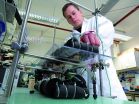(Press-News.org) While unconscious race and social class biases were present in most trauma and acute-care clinicians surveyed about patient care management in a series of clinical vignettes, those biases were not associated with clinical decisions, according to a report published online by JAMA Surgery.
Disparities in the quality of care received by minority patients have been reported for decades across multiple conditions, types of care and institutions, according to the study background. Adil H. Haider, M.D., M.P.H., of Brigham and Women's Hospital, Boston, conducted a web-based survey among physicians from surgery and related specialties at an academic, level I trauma center.
The authors used the Implicit Association Test (IAT) for race and class to measure the strength of a person's automatic associations. Unconscious attitudes were assessed according to the speed with which respondents pressed computer keys as a way to gauge the ease with which respondents sorted out mental concepts. The study included four race vignettes and four social class vignettes with patients who were white and black and of upper and lower social class.
The study results included 215 clinicians (74 attending surgeons, 32 fellows, 86 residents, 19 interns and four physicians). The authors found implicit race and social class biases were present for most respondents. Average test scores among all clinicians were 0.42 for race (indicates moderate preference) and 0.71 for social class (indicates strong preference). Scores did not differ significantly by practitioner specialty, race or age. Subtle differences in scores between women and men were not significant in further analyses.
Some analysis indicated an association between race and social class biases among survey responders in 3 of 27 possible patient management decisions in the survey vignettes, including respondents being more likely to diagnose a young black woman with pelvic inflammatory disease rather than appendicitis and being less likely to order an MRI of the cervical spine for patients with neck tenderness after a motor vehicle accident if they were of low rather than high socioeconomic status. However, those differences were not significant in further analysis and authors, overall, found no differential patient treatment related to race or social class biases.
"Although this study of clinicians from surgical and other related specialties did not demonstrate any association between implicit race or social class bias and clinical decision making, existing biases might influence the quality of care received by minority patients and those of lower socioeconomic status in real-life clinical encounters. Further research incorporating patient outcomes and data from actual clinical interactions is warranted to clarify the effect of clinician implicit bias on the provision of health care and outcomes," the study concludes.
INFORMATION:
(JAMA Surgery. Published online March 18, 2015. doi:10.1001/jamasurg.2014.4038. Available pre-embargo to the media at http://media.jamanetwork.com.)
Editor's Note: The authors made funding/support disclosures. Please see the article for additional information, including other authors, author contributions and affiliations, financial disclosures, funding and support, etc.
Media Advisory: To contact corresponding author Adil H. Haider, M.D., M.P.H., call Lori Schroth at 617-525-6374 or email ljschroth@partners.org.
To place an electronic embedded link to this study in your story: Links will be live at the embargo time: http://archsurg.jamanetwork.com/article.aspx?doi=10.1001/jamasurg.2014.4038.
ANN ARBOR, Mich. - Drugs aimed at quelling the behavior problems of dementia patients may also hasten their deaths more than previously realized, a new study finds.
The research adds more troubling evidence to the case against antipsychotic drugs as a treatment for the delusions, hallucinations, agitation and aggression that many people with Alzheimer's disease and other dementias experience.
In the new issue of the journal JAMA Psychiatry, researchers report findings from nearly 91,000 American veterans over the age of 65 with dementia.
Data from each patient who ...
TORONTO (March 18, 2015) - People with a severe form of schizophrenia have major differences in their brain networks compared to others with schizophrenia, bipolar disorder and healthy individuals, a new study from the Centre for Addiction and Mental Health (CAMH) shows.
The study, which used a novel approach to map brain networks, was led by researchers at the Campbell Family Mental Health Research Institute at CAMH and published in this week's JAMA Psychiatry.
"Finding ways to help this particular group of people with schizophrenia is a priority as recovery is ...
COLLEGE STATION - A ground-breaking Texas A&M AgriLife Research-led study on corn has identified useful gene variations for yield increases, drought tolerance and aflatoxin resistance that could make a real difference to Texas producers in the years to come, according to researchers.
The study, titled "Genome Wide Association Study for Drought, Aflatoxin Resistance, and Important Agronomic Traits of Maize Hybrids in the Sub-Tropics" was recently published in PLOS ONE, an international, peer-reviewed, open-access, online publication.
The study included the growing years ...
From computers, tablets, and smartphones to cars, homes, and public transportation, our world is more digitally connected every day. The technology required to support the exchange of massive quantities of data is critical. That's why scientists and engineers are intent on developing faster computing units capable of supporting much larger amounts of data transfer and data processing.
A new study published in Nature Photonics by Tel Aviv University researchers finds that new optical materials could serve as the nuts and bolts of future ultra-high-speed optical computing ...
TORONTO, March 18, 2015--Researchers have defined a new bodily process in mice that may explain why blood oxygen levels are lower for patients with cystic fibrosis when they get a lung infection.
"Infected areas of the lung are not as capable as healthy tissue at adding oxygen to the bloodstream, but no one has shown why this is the case," said Dr. Wolfgang Kuebler, a scientist in the Keenan Research Centre for Biomedical Science of St. Michael's Hospital. "We've shown that the protein produced by a gene known as CFTR is required to direct blood flow away from infected ...
This news release is available in Spanish. Using discarded electronic boards, the UPV/EHU researcher Andoni Salbidegoitia has, in collaboration with international researchers, developed a system for obtaining clean hydrogen that can be used as fuel. The researchers have already registered the patent of the process in Japan.
The Chemical Technologies for Environmental Sustainability (TQSA) Group of the Department of Chemical Engineering of the UPV/EHU's Faculty of Science and Technology is aiming to make use of discarded plastic as effectively as possible from the ...
Bats are not as stereotyped when they hunt as previously believed. New research shows that these flying mammals are capable of making ultra-fast decisions about how to attack their prey - or maybe even call off the attack. It takes only milliseconds.
Bats use echolocation for orientation. They emit ultrasonic sounds, which hit potential prey nearby, sending an echo back to the bat. From this echo the bat can define where the prey is and attack it. A new study has examined how hunting bats react when approaching their prey. The study concludes that bats are capable of ...
Imagine a loved relative suffering from cancer - and you could not afford a treatment because the drugs are too expensive. The Austrian Centre of Industrial Biotechnology (acib) developed a method with the power to reduce production costs of highly valued drugs significantly.
Without antibodies we would be at the mercy of pathogens or cancer cells. Therapeutic antibodies are used as passive vaccines, for cancer therapy or for controlling autoimmune diseases such as multiple sclerosis. According to "bccresearch.com" the global market for antibody drugs was worth nearly ...
Researchers have fine-tuned a technique for coating gold nanorods with silica shells, allowing engineers to create large quantities of the nanorods and giving them more control over the thickness of the shell. Gold nanorods are being investigated for use in a wide variety of biomedical applications, and this advance paves the way for more stable gold nanorods and for chemically functionalizing the surface of the shells.
Gold nanorods have a lot of potential applications, because they have a surface plasmon resonance - meaning they can absorb and scatter light. And by ...
This news release is available in Spanish. Alzheimer's disease is the most significant cause of dementia in the elderly: it affects over 35 million people worldwide. It is reckoned that Alzheimer's could reach epidemic proportions in developed countries unless therapies to cure or prevent it are obtained. Studies conducted so far reveal that the therapies are more effective when they are applied before the brain has become severely damaged. What is more, the spotting of early phases of the disease may help to develop new treatments. Right now, to make a clinical diagnosis ...


